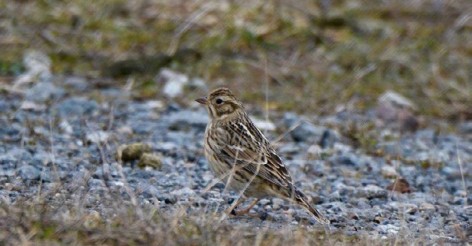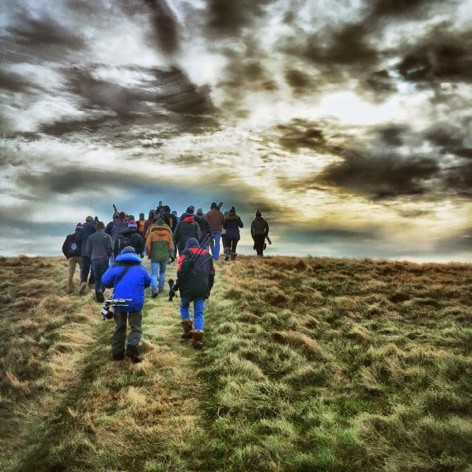Soheil Zendeh

Smith’s Longspur. Photograph by Norman Hyett.
My first post to Massbird on December 22, 2015, noted nothing extraordinary:
Despite the efforts of 18 wind-blown searchers on Monday, Dec 21, no Swainson’s Hawk was seen at Bear Creek in Saugus. However, 2 new count week species for the Greater Boston CBC were added: a Rough-legged Hawk and a Lapland Longspur.
This was in the wake of the Saugus Christmas Bird Count crew finding a Swainson’s Hawk at the Bear Creek wildlife sanctuary on Sunday, December 20, 2015. I mentioned finding the longspur for CBC count week. I assumed it was a Lapland because—what else could it be? Jan Smith heard a longspur fly over and Tim Factor saw it land and take off several times and saw the conspicuously white outer tail feathers. We all expected to find a Lapland—and there it was. Too bad, we thought, that the bird had not been found on count day.
Also on December 22, this is what Geoff Wilson, our chaperone at Bear Creek, wrote, “The day after the CBC when we were looking for the Swainson’s Hawk, Stephen and I were sitting in my truck talking about how bold the [longspur’s] outer white tail feathers were.” So it went for several more weeks. Geoff or someone else would see a solitary bird, one that did not associate with Horned Larks or other ground- feeding birds. But it was only seen after being flushed, flashing those bright outer tail feathers as it flew away.
Finally, on Monday January 18, 2016, my Massbird post had an entirely different subject: “Smith’s Longspur at Bear Creek.” Here is the text in its entirety:
On today’s otherwise uneventful Bear Creek walk, we spent a lot of time studying a longspur—which may have been 2 different birds. The first one, extremely secretive, was deemed by some to be a Lapland, but frankly I never got a good enough look at it to be sure of anything. The second one (if it was a second one) was extremely tame and allowed close approach by our whole group. Once I got it in the scope I began to doubt seriously that it was a Lapland. There simply was no rufous or ochre anywhere near the face or hindneck—or much of anywhere else….
This is what Marshall Iliff said of the photo [of this bird] taken by Norman Hyett, confirming it as a Smith’s Longspur:
Key features shown here are: 1) overall buffy plumage; 2) bright pinkish legs; 3) narrow streaking becoming pencil thin streaks on flanks; 4) lack of a prominent and contrasting rufous wing patch; 5) moderate primary projection; 6) prominent frame to auriculars and large pale spot at lower border; 7) well-defined mantle braces; 8) lack of any rufous on the nape. The one thing that surprises me here is that the eye ring does not appear at all prominent, which is usually the case on Smith’s.
At this point I began to look for additional evidence, including all the photos I could collect of the bird. Most showed pretty much what Norman Hyett had captured—all except the bird’s legs, which were nearly completely obscured in the one- to three-inch vegetation it favored.
On Wednesday, January 20, 2016, approximately 30 people came to the Bear Creek sanctuary to look for the Smith’s Longspur. We found it almost immediately less than 50 feet from where we had seen it last. For the entire time that we were there— nearly two hours—the bird was essentially alone, feeding in three-inch-high vegetation and easy to see. Initially it was in bad light, so we slowly circled to its sun side and the entire group had lovely views of the Smith’s in perfect light 20 to 25 feet from us.
We also had the media present. A reporter and a freelance photographer from the Lynn Item came to record this birding event. The management at Wheelabrator, which operates the landfill and wildlife sanctuary at Bear Creek, had been alerted to the onslaught of birders coming to see a once-in-a-lifetime bird and notified the local press. They also alerted the local gourmet sandwich shop, which served us an excellent lunch afterwards, courtesy of Wheelabrator.
The eBird report for January 20 indicated that the combined eyes of all of those birders turned up quite a list. A Lapland Longspur, indeed, was present, feeding with Horned Larks, as is habitually the case for this species. A flock of Snow Buntings put in an appearance. A young Bald Eagle, three Northern Harriers, and a first-year Glaucous Gull rounded out the day’s special sightings.

Gathering at Wheelabrator. Photograph by Ram Subramanian.
Marshall Iliff’s note in eBird about the Bear Creek Smith’s Longspur is worth quoting:
…astonishing first winter and third state record for Massachusetts found 17 Jan 2016….This bird [was] seen twice in the same area, and … a longspur sp. was flushed here once or twice previously (first on the day after the Boston CBC). Chestnut-collared Longspur eliminated by moderately long primary projection, prominent frame to the auriculars, and whitish mantle braces. Key field marks distinguishing it from Lapland Longspur are: 1) overall buffy plumage including throat, auriculars, and all of the underparts; 2) pale sandy upperparts with little contrast except whitish mantle braces; 3) narrow breast streaking becoming pencil thin streaks on flank and with no black patches on underparts; 4) secondary panel contrastingly rich buff (or pale rufous) on the edges, but nothing like the chestnut panel of Lapland; 5) prominent frame to auriculars and large pale spot at lower border; 6) brightest rufous color along the rear edge of the auricular frame and very faint, with the nape actually contrastingly grayer (colder) than the buff on the rest of the head and upperparts and very unlike the rich rufous nape of Lapland. 7) very faint, thin white eye ring was almost impossible to see against the pale buff face but was apparent with very close views (and shows in the photos below) although it looks like some feathers of the eye ring may be missing. Given the lack of obvious white lesser coverts, indistinct eye ring, and generally non-contrasting plumage I assume this is a female and probably a first-winter. Leg color was never seen as this bird stayed back on its haunches the entire time we observed it. I could clearly see that the outermost rectrix was white, but never saw the spread tail and could not see the second white tail feather (although others said they did see this). Towards the end of my (MJI) observation it made one short flight and gave two flight calls, which were a solid, metallic rattle like Lapland but slower and composed of 4–5 distinct notes that could almost be counted.
Eye ring: Chris Floyd, who perused the bird carefully for a long time, assured me that this longspur had much a brighter white eye ring on its right side and also more white on the right side secondary coverts.
Leg color: Norman Hyett’s photo clearly shows pinkish legs; they are not exactly the bright pink that Marshall Iliff describes, but are certainly pale. Where visible, the legs in all of my photos of Lapland Longspurs are dark brown or black. Godfrey (1979) states that Smith’s young and females have pale brown legs, paler than other longspurs.
Calls: I asked Jan Smith, who originally had heard the bird fly overhead and call on December 20, to listen to recorded calls of Lapland and Smith’s Longspurs. He reported, “I just listened to flight calls for both Smith’s and Lapland Longspurs and the call that I heard seems most consistent with the recordings for the Smith’s.”
After the extremely successful attempt on January 20 to relocate the Smith’s Longspur, we made two additional trips to the site. On Wednesday, January 27, 52 people came to look for the bird; there was no media contingent this time, but lunch was served again. However, there was no bird to be seen. Four days later, on January 31, nearly 60 people arrived at the site but again we were not successful in finding it. However, some sharp-eyed members of the Tufts Ornithological Club found three Lapland Longspurs.
It is apparent that the Smith’s Longspur has left the area or moved. Since it is solitary and does not flock with other ground-feeders, it will be difficult to relocate.
There have been two previous records of Smith’s Longspur in Massachusetts: On October 12, 1968, Chris Leahy identified and described an individual from Salisbury Beach (Veit and Petersen 1993).
On November 9, 2014, Alan Trautmann photographed a longspur at Nahant that was identified as Smith’s upon closer perusal (eBird 2014).
I’ll share here some of the information I have gleaned about this species. The Birds of Canada (Godfrey 1979) shows the breeding range of Smith’s Longspur as spanning northern Alaska as well as the far north and northwest of Canada in tundra habitat. The easternmost breeding birds nest along the southern shore of Hudson Bay. They migrate mainly through Manitoba, Saskatchewan and Alberta and winter from Kansas and Iowa, south to Oklahoma, Central Texas, northwestern Louisiana, Mississippi and Alabama, rarely in Tennessee.
Birds of North America (BNA) covers the breeding biology of Smith’s Longspur at length. It has the unusual mating habit of being polygynandrous. Here is how BNA describes this system:
… each female pairs and copulates with two or three males for a single clutch of eggs, at the same time that each male pairs and copulates with two or more females. Males do not defend territories, but instead guard females by following them closely and compete for fertilizations by copulating frequently in order to dilute or displace sperm from other males. Over a period of one week in the early spring, a female longspur will copulate over 350 times on average; this is one of the highest copulation rates of any bird. Males are well-equipped to deliver such large numbers of ejaculates—their testes are about double the mass of those of the monogamous and congeneric Lapland Longspur (C. lapponicus).
The birds nest in colonial groups. Males help in feeding the young. Two or more males may assist, and the amount of food each provides seems proportional to the number of young he sired. BNA continues, “Perhaps the advantages females obtain from extra male help in raising offspring may explain why they pair and mate with more than one male.” image
References
- Briskie, J. V. 2009. Smith’s Longspur (Calcarius pictus). The Birds of North America Online (A. Poole, Ed.). Ithaca: Cornell Lab of Ornithology; Retrieved from the Birds of North America Online on February 11, 2016.
- eBird. 2014. Accessed February 11, 2016.
- Godfrey, W. E. 1979. The Birds of Canada. Ottawa: National Museums of Canada.
- Veit R. R. and W. R. Petersen. 1993. Birds of Massachusetts. Lincoln, Massachusetts: Mass Audubon.
Soheil Zendeh, born in Tehran, grew up in Tehran and Tangier, Morocco, arrived in Cambridge in 1961 as a college freshman and later started an auto repair shop first in Cambridge, then in Watertown. He began birding in 1973, never got a good look at the Newburyport Ross’s Gull, got sick of driving to the North Shore for birds, and began checking out local Boston spots in 1975. Since 2009 he has been guiding bird tours at Bear Creek Sanctuary in Saugus. Soheil lives in Lexington with his wife Christine.
The author thanks all the people who helped pin down this bird: Geoff Wilson, Tim Factor, Norman Hyett, Marshall Iliff, and Jan Smith. Also, thanks to the researchers whose work was summarized in Birds of North America: James V. Briskie and Joseph R. Jehl, Jr.